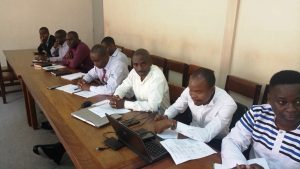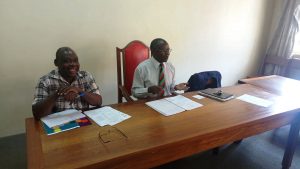Makerere University College of Agriculture and Environmental Sciences (CAES) and Michigan State University’s Borlaug Higher Education for Agriculture Research and Development (BHEARD) Program with the support of the MSU’s Global Center for Food Systems Innovation (GCFSI) are working together to advance CAES toward its strategic vision “to be a leading institution of academic excellence and innovations in Africa.”

The CAES Innovation Scholars Program (CAESISP), offers an eighteen-month opportunity during which CAES academic personnel can work as interdisciplinary teams to solve food system problems that are relevant to the food systems in Africa, while at the same time offering support to the entire CAES academic team in the areas of design thinking, teaching and learning, community outreach, and communicating science.
The CAESISP will serve as a catalyst to support food system innovations that improve food security, and develop the current and next generation of entrepreneurial scientists at Makerere University and in the region.
The program is modelled after a successful, field-tested faculty development program implemented at the Lilongwe University of Agriculture and Natural Resources (LUANAR) and the Malawi University of Science and Technology (MUST) —yet tailored for innovation and contextual challenges at Makerere University. The core values of the CAESISP include: participatory, asset-based, learner-centered, contextualized, and evaluative.
The first CAESISP administration and design team meeting was held on 24th September 2019 at the School of Agricultural Sciences (SAS) Conference Room. The key objectives for the meeting were; to give clarity and understanding of the CAESISP concept, to explain the design process and to explain the administrative and logistical issues for the CAESISP.

The meeting was attended by the Principal of CAES Prof. Bernard Bashaasha, Deans of Schools in CAES, Heads of Department in CAES, and the Design Team nominees from departments and schools within CAES. The US-based institutional capacity development team, included Dr. John Medendorp who is the Director of BHEARD; Dr. John Bonnel, the BHEARD Capacity Development Specialist; Dr. Cait Goddard MSU’s BHEARD Institutional Capacity Development Lead; and Mr. Keith Ives the Monitoring and Evaluation expert. The Meeting was hosted by the Department of Agribusiness and Natural Resource Economics (DANRE).
The Head of DANRE Dr. Elepu Gabriel said the initial processes had taken as a pre-cursor to the meeting. This included discussions with MSU regarding introducing the Innovation Scholars Program idea to CAES, determination of selection criteria for the Design Team, identification of Design Team members, introducing Design team members to MSU team via Skype, introducing the ISP concept to the CAES College Board and facilitating travel plans for the MSU team to come to CAES.

He explained that the ISP is a different way of thinking about innovative ways to do the core mandate of CAES adding that the objective of this face-to-face meeting was to enable every participant fully interact with the MSU team and understand the design process in addition to understanding the administrative and logistical issues regarding the project.
“Each department nominated a representative to attend and the administration will have a pivotal role to play in this college-wide project” said Dr. Elepu Gabriel.
The Principal CAES Prof Bernard Bashaasha thanked participants for attending the meeting in large numbers – an indication that they valued the innovation idea. He pointed the CAES strength in terms of diversity bringing together forestry, geography, tourism, food science, engineering, economics, soils, livestock, extension studies and more among the three schools and eight departments.
He said BHEARD has been collaborating with different members in CAES for a while, and was glad that the new collaboration involves the entire college.
“BHEARD is not new in CAES and the collaboration has taken some years for instance there have been staff and student exchange programs with BHEARD” said Prof. Bashaasha.
He appreciated the fact that the Coordination unit at DANRE had shared the CAESISP concept note with all participants and hoped that everyone had had a chance to internalize it prior to this meeting.

Dr. John Medendorp, the ISP team leader highlighted that institutional capacity building is one of the mandate areas for Michigan State University (MSU). He stated that USAID is implementing numerous projects in Uganda along the line of food systems and hence this served as an opportunity for the CAESISP project to propel to greater heights, possible through deliberate linkages.
He noted that a similar initiative was implemented at Malawi’s Lilongwe University of Agriculture and Natural Resources (LUANAR) and at MUST (Malawi University of Science and Technology). He cited an example of LUANAR where faculty and administrators participated in the project with the main focus of equipping graduates with the skills and mindset tools to solve the region’s development challenges. He concluded by emphasizing that the meeting was a beginning of a new conversation and that the participants should help to design and own the project at CAES to enhance sustainability.
Through a participatory exercise, members were taken through several stages aimed at understanding the concept of innovative research; Identification of the current issues that could affect the achievement of the ISP mission and Determining ways of fostering and nurturing the innovation culture at CAES.
Summary of Key issues discussed:
| KEY ISSUES | MAIN POINTS NOTED |
| 1. Biggest challenge to achieve the CAESISP mission |
|
| 2. Key definitions of what an academic research is all about |
|
| 3. The aspects of the Innovation Scholars Program that would foster a culture of innovation at CAES-Mak |
|
| 4. The aspects of the ISP project that would best fit at Makerere |
|
| 5. Core functions of the Design team |
|
Report compiled by;
Ogenrwoth Brian
